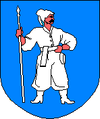Uman
| Uman | ||
| Умань | ||

|
|
|
| Basic data | ||
|---|---|---|
| Oblast : | Cherkasy Oblast | |
| Rajon : | District-free city | |
| Height : | 166 m | |
| Area : | 41.0 km² | |
| Residents : | 88,300 (January 1, 2004) | |
| Population density : | 2,154 inhabitants per km² | |
| Postcodes : | 20300 | |
| Area code : | +380 4744 | |
| Geographic location : | 48 ° 45 ' N , 30 ° 13' E | |
| KOATUU : | 7140800000 | |
| Administrative structure : | 1 city | |
| Address: | пл. Леніна 1 20300 м. Умань |
|
| Website : | http://uman-rada.gov.ua/ | |
| Statistical information | ||
|
|
||
Uman ( Ukrainian and Russian Умань ) is a city in the central Ukrainian Cherkassy Oblast . It is the administrative seat of Uman Rajon .
history
The foundation of the city is not clearly secured. Even if there are traces of settlement up to 3000 BC Chr. Could be proven, so a continuous settlement was not possible until modern times due to repeated incidents of cavalry . The first documentary mention in 1609 also mentions the Uman desert , which was given to the Polish magnate VA Kalinowski. The settlement quickly gained in population in the following decades. It received city rights in 1616 and in 1629 already had 6,000 inhabitants. In 1706 it was granted Magdeburg city rights .
In 1768 took place during the Kolijiwschtschyna uprising of haidamaka led by Maksym Salisnjak and Ivan Gonta the massacre of Uman place in which estimated about 2,000 Jews and Poles were murdered in the city. In 1802 the Sophienparkanlage was opened in Uman . This was built on the instructions of the Polish magnate Stanisław Szczęsny Potocki by the engineer Ludwig Metzel , based on the example of English landscape gardens. The park is named after the client's Greek wife, Sophie Potocka .
Uman developed into an important Jewish center from the 18th century until the Holocaust. For economic reasons, many Jews settled in what is now Poland and Lithuania. Around 1900 around 60% of the population were Jews.
In World War II there were 1941 in the vicinity of the city between the Wehrmacht and the Red Army for the Battle of Uman . This lasted from August 3 to 8, 1941, with both warring parties suffering great losses. Around 100,000 Soviet soldiers were taken prisoner by Germany. After the city was captured by the Wehrmacht, a field airport was set up on the northeastern outskirts of the city. After the Red Army had advanced almost as far as the field airport with a wedge at the end of January 1944, which was pushed back up to the height of Zvenyhorodka , they succeeded in retaking Uman in the first week of March 1944 as part of the Uman-Botosan operation . Immediately thereafter, the NKVD assembly camp No. 33 for prisoners of war was set up on the outskirts.
During the German occupation over 14,000 Jews were deported from Uman.
Pilgrimage site for Hasidic Jews
In 1963, Rabbi Gedaliah Fleer, who lives in New York, came to the actually blocked city of Uman in search of Rabbi Nachman's grave , after he had been arrested shortly before Uman the year before. Word of this success quickly spread. This was followed by further illegal trips; in the later Soviet period there were individual trips to Uman organized by the official Intourist agency . After the collapse of the Soviet Union , the city developed into a Jewish pilgrimage site, meanwhile around 30,000 pilgrims come to Rosh Hashanah alone.
Economy and Transport
The city's economic focus is on mechanical engineering and the chemical-pharmaceutical industry. Uman is on the motorways M 05 ( Kiev - Odessa ) and M 12 ( Vinnyzja - Kropywnyzkyj ), which intersect in the city.
sons and daughters of the town
- Ivan Skoropadskyj (1646–1722), hetman of the Ukrainian Cossacks
- Mykola Biljaschiwskyj (1867–1926), Ukrainian archaeologist, anthropologist, ethnographer and art historian.
- Mordechai Spektor (1858–1925), Yiddish narrator
- Jan Cherniavsky (1892–1989), Canadian pianist
- Mischel Cherniavsky (1893–1982), Canadian cellist
- Ilya Maiselis (1894–1978), Ukrainian-Russian chess player, theorist, historian and writer
- Igor Smolitsch , church historian
- Valentin Gitermann (1900–1965), Swiss historian, teacher, editor and politician
- Jurij Smolytsch (1900–1976), Ukrainian-Soviet writer
- Elie Spivak (1902–1960), Canadian violinist and music teacher
- Ivan Chernyakhovsky (1906–1945), Soviet general
- Sara Barkin (1908–2002), Canadian singer and pianist
- Mark Zborowski (1908–1990), anthropologist and NKVD agent
- Jack Barkin (1914-1996), Canadian singer
- Iossif Ilyich Gichman (1918–1985), mathematician
- Yakiv Lapynskyj (* 1928), composer
- Oleksij Pavlenko (* 1977), Ukrainian minister
- Volodymyr Ostaptschuk (* 1984), radio and television presenter
Individual evidence
- ↑ entry HAIDAMACKS in the Jewish Encyclopedia , accessed on April 5, 2016
- ^ Paul R. Magocsi: Historical Atlas of Central Europe . University of Washington Press, Seattle 2002. ISBN 978-0-295-98146-8 . P. 109.
- ↑ Konrad Schuller : In the new shtetl. The Jews in Uman, Ukraine, were deported by Stalin and murdered by Hitler. The great rabbi's grave disappeared under concrete. Now the Hasids are back. They come by the thousands from New York and Israel, singing and dancing. Your highest commandment is real joy . In: Frankfurter Allgemeine Sonntagszeitung, September 22, 2013.
- ↑ Hasids? - No thanks! In: Jüdische Allgemeine, September 13, 2012.
- ↑ Cathrin Kahlweit: Dancing to God. When the Jews celebrate New Year, there is a state of emergency in Uman . In: Süddeutsche Zeitung of September 26, 2014, p. 13.



